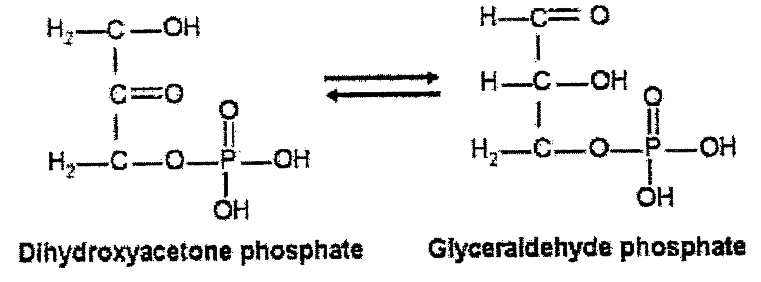Dihydroxy acetone phosphate is a common respiratoryintermediate metabolite of
Amino acids and glycerol
Glucose and fatty acids
Glycerol and glucose
Fatty acids and amino acids
To determine what dihydroxyacetone phosphate (DHAP) is a common respiratory intermediate metabolite of, we can analyze the glycolytic pathway where DHAP is formed.
1. Understanding Dihydroxyacetone Phosphate (DHAP):
- DHAP is a three-carbon sugar phosphate that plays a crucial role in glycolysis, which is the metabolic pathway that converts glucose into pyruvate, generating energy in the form of ATP.
2. Identifying the Glycolytic Pathway:
- Glycolysis begins with glucose, which is a six-carbon sugar. The pathway involves several steps where glucose is phosphorylated and split into smaller molecules.
3. Formation of DHAP:
- During glycolysis, glucose is first converted to glucose-6-phosphate, then to fructose-6-phosphate, and subsequently to fructose-1,6-bisphosphate.
- The enzyme aldolase catalyzes the cleavage of fructose-1,6-bisphosphate into two three-carbon molecules: glyceraldehyde-3-phosphate (G3P) and dihydroxyacetone phosphate (DHAP).
4. Conclusion:
- Since DHAP is formed during the breakdown of glucose in glycolysis, it is primarily associated with glucose metabolism. Therefore, DHAP is a common respiratory intermediate metabolite of glucose.
5. Evaluating the Options:
- Based on the analysis, we can conclude that DHAP is not directly associated with amino acids or fatty acids. The correct association is with glucose.
Final Answer:
Dihydroxyacetone phosphate is a common respiratory intermediate metabolite of Glucose.
---
- DHAP is a three-carbon sugar phosphate that plays a crucial role in glycolysis, which is the metabolic pathway that converts glucose into pyruvate, generating energy in the form of ATP.
- Glycolysis begins with glucose, which is a six-carbon sugar. The pathway involves several steps where glucose is phosphorylated and split into smaller molecules.
- During glycolysis, glucose is first converted to glucose-6-phosphate, then to fructose-6-phosphate, and subsequently to fructose-1,6-bisphosphate.
- The enzyme aldolase catalyzes the cleavage of fructose-1,6-bisphosphate into two three-carbon molecules: glyceraldehyde-3-phosphate (G3P) and dihydroxyacetone phosphate (DHAP).
- Since DHAP is formed during the breakdown of glucose in glycolysis, it is primarily associated with glucose metabolism. Therefore, DHAP is a common respiratory intermediate metabolite of glucose.
- Based on the analysis, we can conclude that DHAP is not directly associated with amino acids or fatty acids. The correct association is with glucose.
Dihydroxyacetone phosphate is a common respiratory intermediate metabolite of Glucose.
Topper's Solved these Questions
- BOOK - AAKASH INSTITUTECHAPTER - TEST 1EXERCISE - Examplle18videos
TEST 1
- BOOK - AAKASH INSTITUTECHAPTER - STRUCTURAL ORGANISATION IN ANIMALS (CONTD . . .) (ANIMAL MORPHOLOGY)EXERCISE - Assignment (Section-D)10videos
STRUCTURAL ORGANISATION IN ANIMALS (CONTD . . .) (ANIMAL MORPHOLOGY)
- BOOK - AAKASH INSTITUTECHAPTER - TEST 2EXERCISE - EXERCISE459videos
TEST 2
Similar Questions
Knowledge Check
- Question 1 - Select One
Acetone is
Aa pungent smelling liquidBinsoluble in ethanolCinsoluble in etherDsoluble in water in all proportions - Question 2 - Select One
Dihydroxy acetone phosphate and glyceraldehyde-3-phosphate are reversibly interconvertible

The enzyme that catalyzes the above reaction isAAldolaseBIsomeraseCPhospho glycerokinaseDPhospho glyceromutase - Question 3 - Select One
Enzyme aldolase which helps in combining dihydroxy acetone phosphate with glyceraldehyde phosphate belongs to the category of
ALigasesBHydrolasesCTransferasesDlyases.
Assertion: Fructose-1, 6 diphosphate is converted into glyceraldehyde-3-phosphate and dihydroxy -acetone -3-phosphate.
Reason: Conversion of fructose-1,6 diphosphate into 3-phosphoglyceraldehyde and dihydroxyace -tone -3-phosphate is facillated by the enzyme aldolase.View SolutionWhich of the metabolites is common to respiration mediated breakdown of fats, carbohydrates and proteins ?
View SolutionWhich of the metabolites is common to respiration mediated breakdown of fats, carbohydrates and proteins ?
View SolutionWhich of the metabolites is common to respiration mediated breakdown of fats, carbohydrates and proteins ?
View SolutionWhich of the metabolites is common to respiration mediated breakdown of fats, carbohydrates and proteins ?
View Solution

